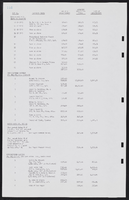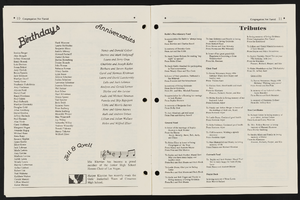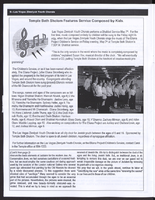Search the Special Collections and Archives Portal
Search Results

Transcript of interview with Sam Earl by Laura Button, March 9, 1981
Date
Archival Collection
Description
On March 9, 1981, Laura Button interviewed Sam Earl (born 1912 in Virgin, Utah) about his life in Nevada. Also present during the interview is Sam’s wife, Melissa Earl. The three discuss a wide range of topics from the early development of Las Vegas, Sam’s work on the Boulder Dam, the Earls’ early residence in a tent, and the family’s religious participation. The interview also covers gambling, Block 16, the first members of the police force, recreational activities, and the Helldorado parade. Sam also talks about his work as a building contractor, including some of the buildings and casino properties he helped build, and the interview moves to a discussion of the development of the Las Vegas Strip. The interview concludes with Sam’s description of his work as a truck driver and a discussion on welfare benefits.
Text

Transcript of interview with Donna Newsom by Claytee White, June 11, 2009
Date
Archival Collection
Description
Donna Newsom shares the history of her life in great detail, beginning with her childhood in Georgia and Florida. The family moved many times, following her father's work opportunities. Donna had a close relationship with her father and recalls the many daring adventures on which he took her. After graduating from high school, Donna earned a nursing degree at the Macon Hospital School of Nursing. She remembers dorm life, long hours, and the specific training nurses received in the late forties. Her career began at age 19 with a year of working at Macon Hospital as a graduate nurse, and then she made plans to leave the South. Donna's memories include moving to Houston, living in a boarding house, her first date, and working at Hermann Hospital and then Methodist Hospital. She then answered an ad to work at a Girl Scout camp in Colorado, and her roommate there became a mentor and one of her staunchest supporters. With help from her mentor, Donna went on to earn a teaching degree in Austin, Texas, met and married her husband Sam Newsom, and got involved in real estate. She relates the many experiences they had during Sam's Navy career, her teaching experience in New Orleans, and their eventual move to Las Vegas. Sam and Donna loved Las Vegas from the moment they moved here. She recalls many details of her employment at UMC, the differences in health care compared to down south, and the feeling of being safe no matter the time of day or night. Donna stays active in tutoring, the OLLI program at UNLV, and working for the Salvation Army women's auxiliary. She and Sam also get together with his golfing buddies and their wives for dinners in their various homes.
Text

Chart of coolers and recirculation pumps (Las Vegas), 1950
Date
Archival Collection
Description
List of coolers and how many are equipped with recirculation pumps broken down by subdivision in Las Vegas
Text

Transcript of interview with Marie Jordan by Edward Gentry, February 27, 1981
Date
Archival Collection
Description
On February 27, 1981, Edward Gentry interviewed Marie Jordan in her home in Las Vegas, Nevada. The two discuss social differences between Arizona and Las Vegas, particularly in the ways schools were segregated in Las Vegas. Jordan also discusses the “Whites Only” policy on the Strip and Downtown. The interview concludes with Jordan sharing her views on the importance of helping others.
Text
Hildred Meidell oral history interview
Identifier
Abstract
Oral history interview with Hildred Meidell conducted by Greg Abbott on February 27, 1979 for the Ralph Roske Oral History Project on Early Las Vegas. In this interview, Meidell covers a range of topics about living in Las Vegas, Nevada, from her and her husband’s time as tourists in the city and their subsequent retirement to Las Vegas from Los Angeles, California. Meidell describes the Las Vegas Strip, the interstate and highway conditions between Los Angeles and Las Vegas, as well as their numerous visits to Hoover Dam (Boulder Dam). Moreover, she speaks about the changing layout of the city, the increase in shopping centers and department stores, and the clothing stores inside of hotels. Lastly, Meidell talks about the prominence of churches in local communities, the atomic testing program and the structural damages these tests caused in her neighborhood, and the influence of the railroad and passenger train on the town.
Archival Collection
Margaret Crabbe oral history interview
Identifier
Abstract
Oral history interview with Margaret Crabbe, conducted by Patricia van Betten on January 14 and January 19, 2004 for the History of Blue Diamond Village in Nevada Oral History Project. In this interview, Margaret Crabbe discusses her upbringing in California, her education as a schoolteacher and her move to Blue Diamond, Nevada in 1949. She briefly talks about her husband, Lester, and his work as facilities manager for both the Blue Diamond Mine and Blue Diamond Village. She then discusses her work as a teacher in Blue Diamond and the school children's participation in the dedication of the Blue Diamond Post Office in the 1950s. She also comments on problems with spring flooding in the town and surrounding areas and some of the wild animals that would come into the town. Finally, she talks about her grandfather John W. Bain, who established the first Methodist church in Las Vegas, Nevada.
Archival Collection




